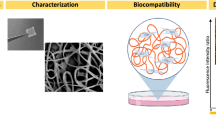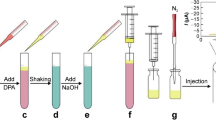Abstract
In this research, electrospun polycaprolactam nanofibers were collected on a fine stainless steel mesh sheet without a binder, and a layer of conductive polyaniline was chemically deposited on the nanofibers. The polyaniline immobilized on the polycaprolactam nanofibers provided high electrical conductivity, acceptable mechanical stability, and a large surface area. This assembly was then used as a working electrode in electrochemically controlled solid-phase microextraction (EC-SPME), a fast and environmentally friendly method. The polymer layers were characterized by SEM and FTIR techniques. Significant factors affecting the EC-SPME efficiency were investigated, including the desorption conditions, the sorbent used, the pH of the sample solution, the extraction voltage, the extraction time, and the ionic strength. Under the optimum conditions, the limits of detection and quantification for the target analytes were 0.9–1.8 μg L−1 and 3.0–6.1 μg L−1, respectively. The linear dynamic range was 5–2000 μg L−1, with R2 > 0.993. The method was coupled with HPLC analysis and applied to the determination of angiotensin ΙΙ receptor antagonists (ARA-ΙΙs) in human plasma, and relative recoveries of 91.1–104.3% with RSDs of ≤8.3% were obtained.





Similar content being viewed by others
References
Farajzadeh MA, Khorram P, Pazhohan A. Simultaneous determination of atorvastatin and valsartan in human plasma by solid-based disperser liquid-liquid microextraction followed by high-performance liquid chromatography-diode array detection. J Chromatogr B. 2016;1017–1018:62–9.
Vinzuda DU, Girish S, Navin S. RP-HPLC method for determination of valsartan in tablet dosage form. Int J Chem Tech Res. 2010;2:1461–7.
Ferreirós N, Iriarte G, Alonso RM, Jiménez RM, Ortíz E. Separation and quantitation of several angiotensin II receptor antagonist drugs in human urine by a SPE–HPLC–DAD method. J Sep Sci. 2008;31:667–76.
González L, López JA, Alonso RM, Jiménez RM. Fast screening method for the determination of angiotensin II receptor antagonists in human plasma by high-performance liquid chromatography with fluorimetric detection. J Chromatogr A. 2002;949:49–60.
Nie J, Zhang M, Fan Y, Wen Y, Xiang B, Feng Y-Q. Biocompatible in-tube solid-phase microextraction coupled to HPLC for the determination of angiotensin II receptor antagonists in human plasma and urine. J Chromatogr B. 2005;828:62–9.
Kondo T, Yoshida K, Yoshimura Y, Motohashi M, Tanayama S. Characterization of conjugated metabolites of a new angiotensin II receptor antagonist, candesartan cilexetil, in rats by liquid chromatography electrospray tandem mass spectrometry following chemical derivatization. J Mass Spectrom. 1996;31:873–8.
Zarghi A, Shafaati A, Foroutan S, Movahed H. Rapid quantification of valsartan in human plasma by liquid chromatography using a monolithic column and a fluorescence detection: application for pharmacokinetic studies. Sci Pharm. 2008;76:439–50.
Gupta K, Wadodkar AR, Wadodkar SG. UV-spectrophotometric methods for estimation of valsartan in bulk and tablet dosage form. Int J Chem Tech Res. 2010;2:985–9.
Stenhoff H, Lagerström PO, Andersen C. Determination of candesartan cilexetil, candesartan and a metabolite in human plasma and urine by liquid chromatography and fluorometric detection. J Chromatogr B Biomed Sci Appl. 1999;731:411–7.
Seki T, Yamazaki K, Kayano M. Determination of angiotensin II receptor antagonist (E4177) in human plasma and urine by high-performance liquid chromatography. J Chromatogr B Biomed Sci Appl. 1997;688:101–6.
Daneshtalab N, Lewanczuk RZ, Jamali F. High-performance liquid chromatographic analysis of angiotensin II receptor antagonist valsartan using a liquid extraction method. J Chromatogr B. 2002;766:345–9.
Iriarte G, Gonzalez O, Ferreirós N, Maguregui MI, Alonso RM, Jiménez RM. Validation of a fast liquid chromatography–UV method for the analysis of drugs used in combined cardiovascular therapy in human plasma. J Chromatogr B. 2009;877:3045–53.
Yeung PK, Pollak PT, Jamieson A, Smith GJ, Fice D. Determination of plasma concentrations of losartan in patients by HPLC using solid phase extraction and UV detection. Int J Pharm. 2000;204:17–22.
Koseki N, Kawashita H, Hara H, Niina M, Tanaka M, Kawai R, et al. Development and validation of a method for quantitative determination of valsartan in human plasma by liquid chromatography-tandem mass spectrometry. J Pharm Biomed Anal. 2007;43:1769–74.
Xue SW, Luo L, Xu L. Magnetic solid-phase extraction of angiotensin II receptor antagonists in human urine and plasma with a reversed-phase/cation-exchange mixed-mode sorbent. J Sep Sci. 2016;39:4812–8.
Pyrzynska K, Kubiak A, Wysocka I. Application of solid phase extraction procedures for rare earth elements determination in environmental samples. Talanta. 2016;154:15–7.
Seidi S, Yamini Y, Rezazadeh M. Electrochemically assisted solid based extraction techniques: a review. Talanta. 2015;132:339–53.
Ahmadi SH, Manbohi A, Heydar KT. Electrochemically controlled in-tube solid phase microextraction. Anal Chim Acta. 2015;853:335–41.
Ahmadifar M, Aziz-Zanjani MO, Jabbari A, Seyed Hashtroudi M. Selective adsorption of 2,4-dinitrophenol on molecularly imprinted nanocomposites of mesoporous silica SBA-15/polyaniline. Analyst. 2012;137:4368–74.
Mehdinia A, Esfandiarnejad R, Jabbari A. Magnetic nanocomposite of self-doped polyaniline–graphene as a novel sorbent for solid-phase extraction. J Sep Sci. 2015;38:141–7.
Kumar A, Jangir LK, Kumari Y, Kumar M, Kumar V, Awasthi K. Optical and structural study of polyaniline/polystyrene composite films. Macromol Symp. 2015;357:229–34.
Yang BY, Cao Y, Qi FF, Li XQ, Xu Q. Atrazine adsorption removal with nylon6/polypyrrole core-shell nanofibers mat: possible mechanism and characteristics. Nanoscale Res Lett. 2015;10:207–20.
Ojha SS, Afshari M, Kotek R, Gorga RE. Morphology of electrospun nylon-6 nanofibers as a function of molecular weight and processing parameters. J Appl Polym Sci. 2008;108:308–19.
Xu Q, Yin X, Wu S, Wang M, Wen Z, Gu Z. Determination of phthalate esters in water samples using nylon6 nanofibers mat-based solid-phase extraction coupled to liquid chromatography. Microchim Acta. 2010;168:267–75.
Hong KH, Oh KW, Kang TJ. Preparation of conducting nylon-6 electrospun fiber webs by the in situ polymerization of polyaniline. J Appl Polym Sci. 2005;96:983–91.
Author information
Authors and Affiliations
Corresponding author
Ethics declarations
The human blood plasma sample was obtained from a healthy volunteer, with informed consent provided to the Iranian Blood Transfusion Organization (Tehran, Iran).
The studies were performed in accordance with the ethical standards approved by the appropriate research ethics committee of University of Tehran.
Conflict of interest
The authors declare that they have no conflicts of interest.
Additional information
Publisher’s note
Springer Nature remains neutral with regard to jurisdictional claims in published maps and institutional affiliations.
Electronic supplementary material
ESM 1
(PDF 259 kb)
Rights and permissions
About this article
Cite this article
Esfandiarnejad, R., Sereshti, H. & Farahani, A. Polyaniline immobilized on polycaprolactam nanofibers as a sorbent in electrochemically controlled solid-phase microextraction coupled with HPLC for the determination of angiotensin II receptor antagonists in human blood plasma. Anal Bioanal Chem 411, 3631–3640 (2019). https://doi.org/10.1007/s00216-019-01845-8
Received:
Revised:
Accepted:
Published:
Issue Date:
DOI: https://doi.org/10.1007/s00216-019-01845-8




